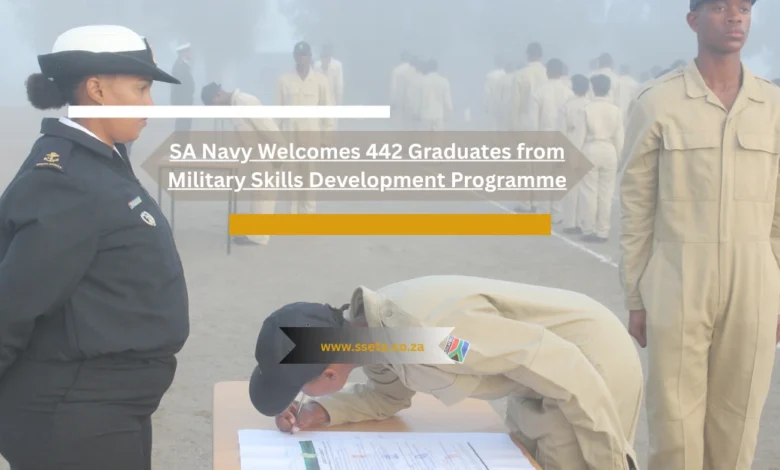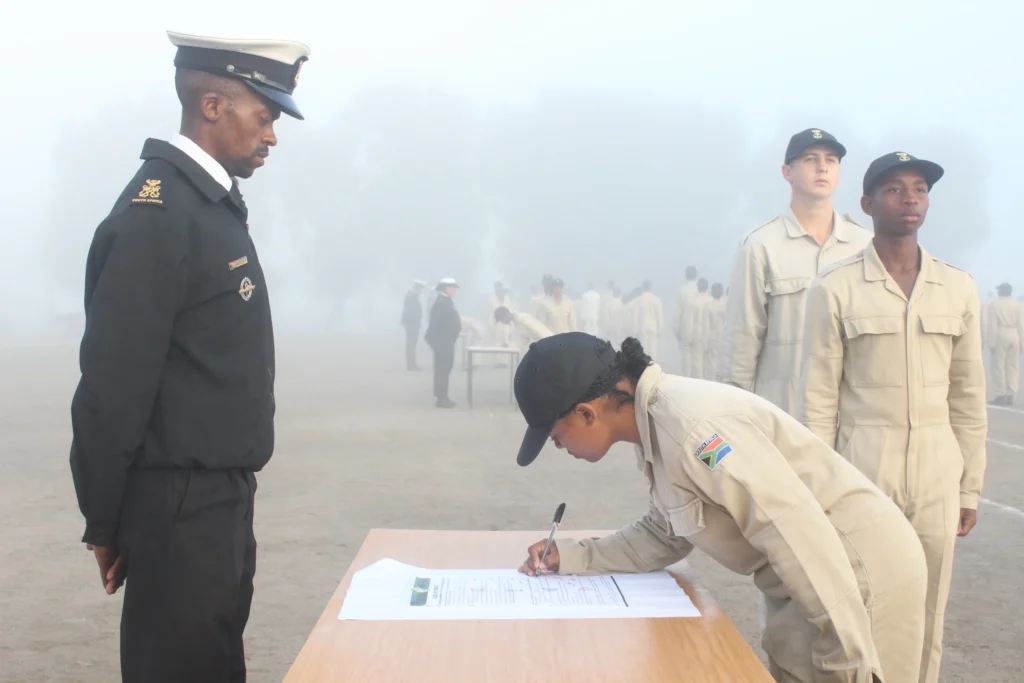SA Navy Welcomes 442 Graduates from Military Skills Development Programme 2025

New Wave of South African Navy Recruits Graduate: Honouring Discipline, Duty, and National Pride
A Defining Moment for 442 New South African Navy Recruits
A sense of pride and patriotism echoed across SAS Saldanha on 25 July 2025, as 442 young men and women marked the successful completion of their Basic Military Training (BMT) under the South African Navy’s Military Skills Development System (MSDS). The passing out parade was more than a ceremonial milestone—it symbolised discipline, growth, and a commitment to national service.
These newly minted sailors—263 men and 179 women—stood in sharp, disciplined formation before family, friends, and senior officials of the South African National Defence Force (SANDF), showcasing their dedication and hard-earned military capabilities. Their journey began 24 weeks ago and culminated in a display of coordinated drills, naval gunnery, and basic combat techniques.
Leading the formal ceremony was Vice Admiral Monde Lobese, Chief of the SA Navy, who delivered a message of pride, warning, and hope to South Africa’s next generation of naval professionals.
The Journey Through Basic Military Training
At SAS Saldanha, located on South Africa’s scenic west coast, recruits undergo intense preparation that molds them both physically and mentally. The BMT programme—central to the Military Skills Development System (MSDS)—is designed to instil core military discipline, physical readiness, and the principles of naval operations.
Recruits begin with fundamental combat training:
- Weapon handling
- Physical training
- Tactical manoeuvres
- Seamanship basics
- Naval history and ethics
Chief Petty Officer Nkululeko Zulu, who spoke on behalf of the training division, described the course as transformative. “The quality of training at SAS Saldanha ensures the development of responsible, value-driven, and disciplined sailors ready for effective integration into the SAN fleet,” Zulu said.
After graduation, these sailors will proceed to functional training where they will specialise in areas such as navigation, logistics, mechanical engineering, communications, or security—depending on their assigned mustering.
Vice Admiral Lobese’s Message to the Recruits
The highlight of the parade came in the form of an inspirational address by Vice Admiral Lobese. He emphasised the Navy’s core values—honour, courage, integrity, commitment, accountability, responsibility, and ethics—as guiding principles that each recruit must uphold.
“You now stand as part of an institution that has a long and storied history,” Lobese told the graduates. “It is now your time to contribute to that history. You are the future of the Navy, and I am confident you will meet that challenge.”
Lobese’s words underscored the importance of duty and character, urging each recruit to remain loyal to their country and the service even beyond their immediate deployment.
The Military Skills Development System: A National Initiative
Launched to build a pipeline of skilled and disciplined military personnel, the MSDS takes in roughly 2,000 volunteers annually, offering them a two-year contract in one of the SANDF’s four arms:
- South African Army
- South African Navy
- South African Air Force
- South African Military Health Service (SAMHS)
For 2025, the intake included:
- 1,591 recruits into the South African Army
- 337 into the Air Force
- 150 into the Military Health Service
- 442 into the Navy
These recruits represent South Africa’s diverse backgrounds, coming from rural towns, urban centres, and coastal communities. The programme is more than a military pipeline—it’s a national developmental platform offering employment, education, discipline, and pride.
The MSDS offers the opportunity to gain:
- Structured military training
- Technical skill development
- Leadership exposure
- Potential full-time employment
After the two-year contract, top-performing recruits may be offered short-term full-time contracts, typically lasting 10 years. Those not absorbed into the permanent force are encouraged to join the Reserve Force, using their acquired military skills to serve the country part-time.

From Civilian to Sailor: Stories of Transformation
The journey to becoming a sailor in the SAN is not an easy one. Many of the new graduates shared stories of adversity and growth. Some had never left their hometowns before. Others had overcome academic and financial challenges. Yet, all of them now wear their navy uniforms with pride, a symbol of what they have achieved.
One recruit from the Eastern Cape said, “I didn’t know what to expect, but I knew I wanted to serve. Now I’ve gained a purpose, friends who are like family, and a career path.”
Another graduate, a young woman from Limpopo, added, “This was the hardest thing I’ve done, but also the most rewarding. I now know that I can handle pressure and that I belong here.”
These personal stories humanise the military training journey and reflect the MSDS’s broader purpose: nation-building through empowerment.
Why the SA Navy Matters More Than Ever
The South African Navy plays a vital role in safeguarding the country’s maritime interests. It is tasked with:
- Protecting national waters
- Conducting search and rescue missions
- Participating in peacekeeping efforts
- Ensuring maritime security
- Supporting anti-piracy and environmental efforts
Given South Africa’s strategic position along major international shipping routes, the SAN remains a crucial institution for both regional stability and national sovereignty.
As geopolitical and environmental challenges evolve, the Navy continues to modernise, making way for new talent, strategies, and technologies. The recent intake of 442 MSDS recruits reflects a strategic commitment to keeping the force young, skilled, and ready.
Looking Ahead: What’s Next for the Recruits?
Having completed their BMT, the recruits will now undergo functional training across various navy bases and divisions. They will be placed into career specialisations where they’ll gain further technical knowledge and serve in operational roles.
Functional training might include:
- Maritime combat and defence systems
- Naval intelligence and surveillance operations
- Engineering support and ship maintenance
- Medical and logistical support units
- Marine environmental safety
Recruits are also encouraged to pursue further studies through military colleges or civilian universities under Defence bursary support.
A Shared Responsibility: Family, Community and Nation
The success of each recruit is not theirs alone—it belongs to the families, communities, instructors, and commanding officers who guided them. The presence of proud parents, siblings, and friends at the passing out parade was a testament to how deeply this moment resonates beyond the individual.
Many parents spoke of the change they saw in their children—discipline, maturity, and confidence. For communities dealing with youth unemployment, programmes like the MSDS serve as a lifeline, offering hope and direction.
Conclusion: A Generation Ready to Serve
As the South African Navy welcomes this new cohort into its ranks, it’s clear that the Military Skills Development System continues to serve as a beacon of national opportunity. These 442 recruits are more than just uniformed personnel—they are symbols of resilience, ambassadors of discipline, and defenders of national integrity.
Their journey may have started with uncertainty, but it now moves forward with purpose. The Navy—and South Africa—has gained a generation willing to serve, ready to lead, and prepared to protect.
Stay Updated
To learn more about MSDS intakes, recruitment opportunities, and SANDF programmes, follow the official SA Navy website or visit your nearest military base recruitment office. The future is shaped by those who step forward—and the sea has many more calling.
